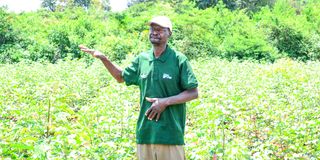Ministry scales up Bt cotton growing in counties as first crop starts to flower

Christopher Ndukuli, a farmer in Busia County, on his Bt cotton farm. Bt cotton matures a month earlier than conventional cotton and produces many more bolls.
What you need to know:
- Bt cotton seeds are developed to kill the African bollworm, which is responsible for up to 100 per cent crop loss.
- Bt cotton matures a month earlier than conventional cotton and produces many more bolls. Experts also say the GM variety can produce up to 1,200 kilos an acre while conventional cotton can yield as low as 200.
- Kenya last year approved commercial farming of Bt Cotton, and in April, the Ministry of Agriculture distributed one metric tonne of Bt cotton seeds for planting on demonstration plots and raised awareness on the transgenic cotton varieties.
- Cotton is grown in 24 out of Kenya’s 47 devolved regions, even though less than 10 have put the crop in their strategic plans.
The commercialisation of insect-resistant genetically modified cotton (Bt cotton) is gaining momentum as the crop starts to flower on farms in Busia, Homa Bay and Siaya, where it was first grown on demo farms.
The government yesterday started distributing Bt cotton seeds in Kitui, Makueni, Kirinyaga, Embu, Meru and Tharaka Nithi counties, which were once the cotton belt of the country alongside western and Nyanza before the death of the crop dubbed white gold in the 1980s.
Some 1,000 farmers have been identified to plant the crop during the October-November short rain season.
In Busia County, the Bt cotton is currently at the flowering stage. “The old varieties had discouraged us, yielding as low as 10 bolls per tree. Many of these Bt cotton trees yield up to 70 bolls,” Francis Opailo, a farmer in Teso South, said.
Francis Okuku, another cotton farmer in Samia, said he expects a bumper crop. His farm has both Bt cotton and ordinary hybrid seeds and the difference is stark.
The Bt cotton seeds are developed to kill the African bollworm, which is responsible for up to 100 per cent crop loss.
Good management
Bt cotton is genetically engineered to have Bacillus thuringiensis (Bt) – a beneficial and naturally occurring bacteria in the soil – to kill the African bollworm, the biggest hurdle in cotton production.
Ordinarily, one has to spray a crop up to nine times under conventional cotton –a great cost to the farmer’s pocket, his health and the environment – but Bt reduces this to only three, according to experts.
Bt cotton matures a month earlier than conventional cotton and produces many more bolls. Experts also say the GM variety can produce up to 1,200 kilos an acre while conventional cotton can yield as low as 200.
Some farmers intercrop their cotton with other crops such as beans, which Dr Charles Waturu, the Bt cotton lead researcher, discourages because the two crops share pests, besides competing for nutrients.
Dr Waturu advises farmers to plant the crop at the onset of long rains to ensure there is enough water.
“A good crop still boils down to good management. Farmers shouldn’t plant Bt and sit on their laurels thinking it is the magic bullet. Otherwise they will get poor results,” he warns.
Kenya last year approved commercial farming of Bt Cotton, and in April, the Ministry of Agriculture distributed one metric tonne of Bt cotton seeds for planting on demonstration plots and raised awareness on the transgenic cotton varieties.
Adhere to quality
Dr Margaret Karembu, the director of the International Service for the Acquisition of Agri-biotech Applications (ISAAA) and chair of the Open Forum on Agricultural Biotechnology in Africa (OFAB-Kenya), says population growth, coupled with climate change and diminishing land sizes, calls for the adoption of the best available technologies that can boost production and cut costs.
The government sees Bt cotton as part of the route for its industrialisation agenda. The ultramodern textile mill in Eldoret operates below capacity even with imports from neighbouring Uganda and Tanzania.
Cotton is grown in 24 out of Kenya’s 47 devolved regions, even though less than 10 have put the crop in their strategic plans.
Officials at Rivatex say they give priority to local cotton, but urge farmers to adhere to quality. Besides textile, cotton also produces seed cake, which is used in animal feeds and cooking oil. This value chain has, however, not been exploited in Kenya.
Rajeev Arora, a former adviser in the Agriculture and Industrialisation ministries who also co-chaired the task force on the revitalisation of cotton, says with the revival of the Rivatex mill, the market has for the first time in Kenya been prepared before the production of a crop.





